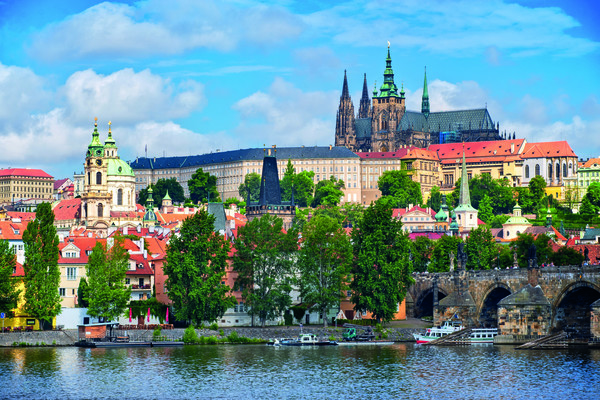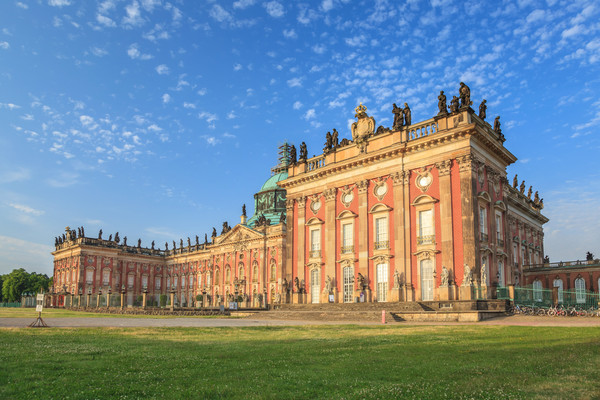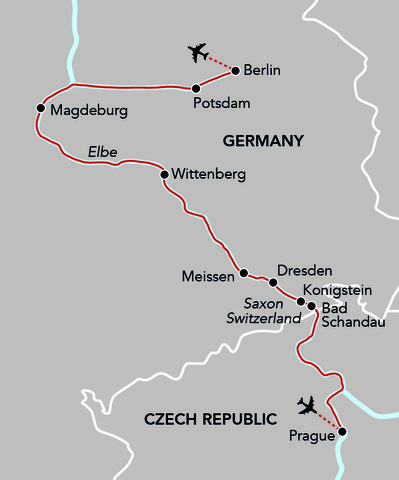Passage Along The Elbe
By Guest Speaker Michael Hindley
It is always with the greatest pleasure that I receive an invitation from Noble Caledonia to be a guest speaker and especially an invitation to join what has become one of my favourite cruises, the Prague to Berlin journey. Both cities are among my favourite European capitals. Over the years I have travelled to Berlin first as a student, then as lecturer and then as a politician; travelling variously by train, plane and car but never by boat until my time with Noble Caledonia. Approaching Berlin through the canals, rivers and lakes of Brandenburg, which take travellers from the river Elbe at Magdeburg to Berlin, is by far the most relaxing and enjoyable way of arriving in Berlin. The Elbe itself once formed the border between the Germanic tribes to the West and the Slavic tribes to the East – a true cultural divide. By one of history’s twists, the Elbe at the town of Torgau became scene of the historical meeting of the US forces and the Red Army in 1945, the event is commemorated by a plaque on the river bank.
The voyage starts in beautiful Prague which provides an eclectic architectural mix of baroque, neoclassical and art décor. Under Prague’s ornate Charles Bridge and below the splendid Hradcany Castle, the river Vltava flows, a river celebrated musically by Smetana in his lyrical “Ma Vlast (My Homeland)”. The route joins the Czech portion of the Elbe (Labe in Czech) and through the tiny and scarcely known Czech wine growing area. The Czechs are famous for their beer, indeed they are Europe’s largest consumer, but their wine is certainly worth tasting beyond its novelty value.

Prague Castle and Charles Bridge
Into Germany, we travel through the curious and striking rock formations of “Saxon Switzerland”, and on to Dresden whose skyline hasn’t changed since Canaletto’s famous painting of its riverscape as the “Florence on the Elbe”. The Baroque Zwinger Palace, the nearby Semper opera house, where Wagner rose to fame, and the Cathedral, which is twinned with Coventry Cathedral, are must visits. Dresden claims to make the best of Germany’s Christmas cakes, the “Stolle”.
Meissen is next, famous for its porcelain and centre of a small but distinctive local wine area. On to Wittenberg, where Luther’s home is now a museum, which rightly pays due homage to his wife, Katharina, the proverbial strong woman behind the great man. The All Saints’Church, where he preached has a masterpiece altar triptych by Cranach the Elder and a surprise and controversial relief on the outside wall. The Castle Church, to whose door Luther nailed his ninety-five theses, which sparked the Reformation and were the Luther himself is buried is at the end of the main street.
Then on to Magdeburg, where voyagers with a scientific bent will recall is the place where Otto von Guericke demonstrated the Magdeburg Hemispheres, an air pump which created a vacuum which ensured the spheres could not be parted by evn the strongest horses. His statue stands near Germany’s first Gothic cathedral. In stark contrast is the quirky building close by which is typical of the Austrian artist, Hundertwasser.
Turning East after Magdeburg into the canals, river and lakes, Potsdam is approached through the calming woods surrounding Berlin. As students in West Berlin we felt hemmed in by the Berlin Wall which formed a ring round the Western Allies zones. We used to lie like sardines in a can on the Wannsee beach looking longingly at the cool woods over on the other bank, forbidden to even the local East Germans during the Cold War.
Almost the whole of the journey is in the former East Germany, and for those us who have known Germany a long time, it is remarkable to see how the drabness of much everyday life has been removed and towns have been spruced up since reunification, thanks to a generous, though burdensome solidarity tax on West Germans.

New Palace in Sanssouci Park, Potsdam
Potsdam, the town itself and last stop before Berlin, gives such evidence. However, it is more famous for Frederick the Great’s rather modest palace Sans Souci (Without Care in French) a reminder that greatness needn’t be displayed by pomposity. We sail under the famous Glienicke Bridge, scene of Cold War spy exchanges, to end the cruise in either the lovely Tegelsee or Spandau whose prison’s last inmate was Hitler’s deputy, Rudolf Hess.
Berlin is now happily reunited and also happily the capital of the reunited Germany. It is now once again the thriving bustling city it had away been. In my students days of the mid sixties the Wall was an attraction for all the wrong reason as brutal evidence of mutual East/West distrust and hostility. The atmosphere was redolent of intrigue and threat well captured by the spy novels of John Le Carre and Len Deighton which became successful films. Now apart from the sections of the Wall kept as tourist’s attraction, it takes the practiced eye of a good guide to point out which streets were East and which streets were West.






